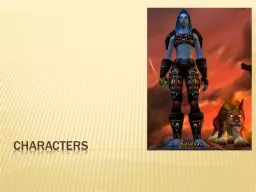

Usually hero Outer and inner problems Antagonist Sidekick Servant Pet NPCs Merchant Trainer Quest giver Higher self Threshold guardian Progress delayer Trickster Mischief maker Herald ID: 700610
Download Presentation The PPT/PDF document "characters characters Protagonist" is the property of its rightful owner. Permission is granted to download and print the materials on this web site for personal, non-commercial use only, and to display it on your personal computer provided you do not modify the materials and that you retain all copyright notices contained in the materials. By downloading content from our website, you accept the terms of this agreement.
Slide1
charactersSlide2
characters
Protagonist
Usually hero
Outer and inner problems
Antagonist
Sidekick
Servant
Pet
NPCs
Merchant
Trainer
Quest giver
Higher selfSlide3
Threshold
guardian
Progress delayer
Trickster
Mischief maker
Herald
Used to facilitate change in the story
Character roles
Higher self
Hero as he aspires to be
Mentor
Teaches the hero
Ally
Meant to aid the hero
Shadow
Ultimate evilSlide4
Character Growth
Must include growth to have a meaningful story
Growth varies by genre
Must decide:
Which characters will grow
How they will grow
Implementation in gameAffect on gameplayRepresentation to playerSlide5
Character GrowthSlide6
Goals of Character Design
Enhance story
Emotional response
Characters to identify with and care about
Credible within the game styleSlide7
Goals of Character Design
Create characters that people …
find intriguing (even if a villain)
can believe in
can identify with
Distinctive enough to be memorableSlide8
Player-Designed Avatars
Flexibility differs by genre
Role-playing games usually greatest
Race, sex, hair, physical attributes, etc.
Typically no personality but what is created
Goal is tools for players to create
themselvesSlide9
Nonspecific Avatars
Designer doesn’t specify anything
Text-based adventure games
Allows very tight connection between player and avatar
Half-Life
’s Gordon Freeman
Limiting for designerSlide10
Specific Avatars
Goals
Personality of their own
Belong in the game
Begins with visual depiction
Player’s relationship more complex
Identify with, not become Slide11
Semi-Specific Avatars
Only partially characterized
Better to make cartoonish
Common with action game avatars
Mario
Lara Croft
“Beyond the bare facts of her biography, her perfect vacuity means we can make Lara Croft into whoever we want her to be.” – Steven Pool, “Lara’s Story”Slide12
Controlling avatars
Indirect (“point and click”)
Doesn’t steer avatar, points to where to go. Player as disembodied guide friend
More likely specific avatar
Direct
Player steers avatar through game world, doing a variety of actions as necessary
More likely nonspecific or semi-specificSlide13
Designing the Avatar
Nonspecific, semi-specific or specific
Visual, psychological, social
Direct or indirect control
Goal: character the player can identify with qualities can appreciateSlide14
Art-Driven Character Design
Creating a character by first thinking about his visual appearance
Visual design
Character physical types
Physical design
Defining attributes
SidekicksSlide15
Visual Design
Realism doesn’t matter, self-consistency does
Pac-Man
Lara Croft
Purely artistic characters tend to be more superficial and one-dimensional
Lets the player impose his own personalitySlide16
Character Physical Types
Humanoids
Non-humanoids
HybridsSlide17
Physical Design
Methods to attract
Hypersexualization
Cuteness
Cartoonlike qualities
Cool, tough, cute, goofy
Culture differences in art styles
Japanese: large eyes and tiny/huge mouths
Cute faces with sexually provocative women
European: often ugly and strange to AmericansSlide18
Defining Attributes
Clothing, weapons, symbolic objects, name
Color palette reflects character’s attitudes or emotional temperament
Superman, upholder of “truth, justice, and the American way”: bright/cheery, American flag
Batman, Dark Knight of Gotham City (grittier, more run-down than Metropolis): somberSlide19
Sidekicks
Most prominent common element in game design
Combine qualities (e.g., tough with cute) to provide variety and comic relief
Benefits
Give player additional moves and actions
Extend emotional range of game
Can give player information they couldn’t get otherwiseSlide20
Story-Driven Character Design
Starting with the story behind the character and developing his traits and personality before considering his appearance
Character dimensionality
Language & accent
Developing believable characters
Character growth
Character archetypesSlide21
Character Dimensionality
Zero-dimensional
May display only discrete emotional states
One-dimensional
Have only a single variable to characterize a changing feeling or attitude
Two-dimensional
Have multiple non-conflicting
variables that express their impulsesThree-dimensional
Have multiple emotional states that
can produce conflicting impulsesSlide22
Language & Accent
Key cue to character’s personality
Vocabulary – age, social class, education
Grammar and sentence construction – education and class
Accent – place of origin and social class
Delivery (speed and tone) – excitement, boredom, anxiety, suspicion, attitude or emotional state
Vocal quirks – distinguishingSound effects also tell about personality
Confirm player’s commandSignal injury, damage, death
Pitch describesSlide23
Believable Characters
Major characters need rich personalities
Answer many questions about them
Where was he born?
What is his education?
What are his favorite activities?
What were his biggest triumphs in life?What are his interesting or important possessions?
etc.Show through appearance, language, and behaviorSlide24
Believable Characters
Attributes – location, health, relationships, etc.
Can change as the player plays the game
Status attributes: change frequently and by large amounts
Characterization attributes: change infrequently and only by small amounts or not at allSlide25
Believable Characters
Three golden guidelines to developing effective, believable characters
Needs to intrigue the player
Needs to get the player to like him
Needs to change and grow according to experience